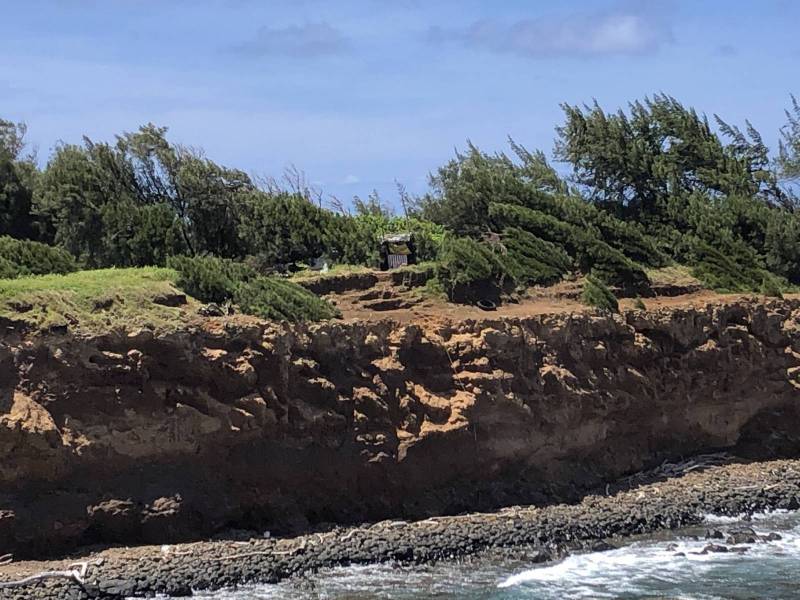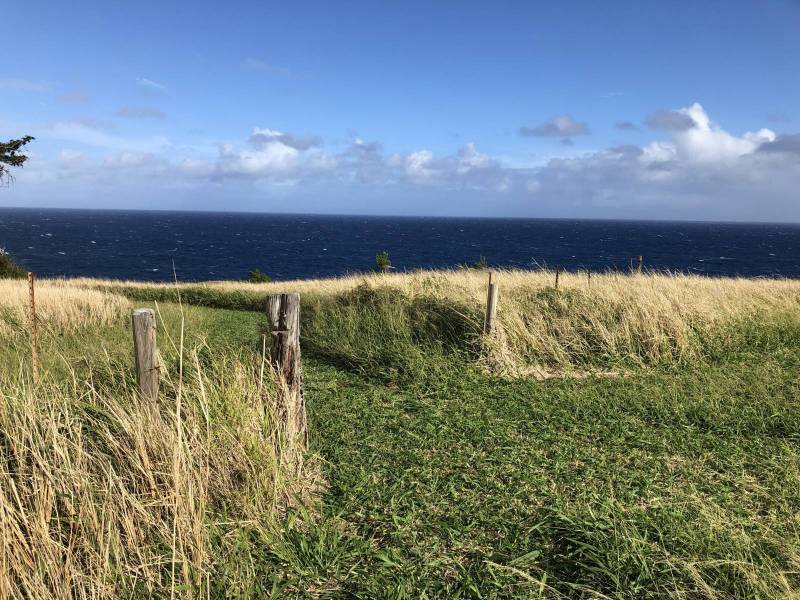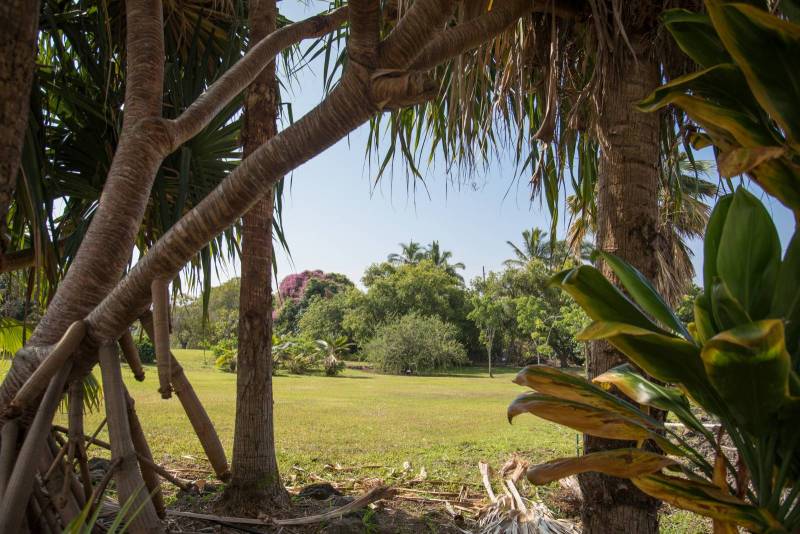You may have heard that the public has the right to access any beach or oceanfront in Hawai’i, a topic I addressed previously in the second half of the post “What You Need to About Buying Oceanfront Property in Hawai’i.” But what does that really mean? How can the public access gain access to these areas? For what purposes?

Looking across “Swimming Pools” surf spot towards Kauhola Point, where an apparent squatter hut is visible.
A few weeks ago an alert went out on social media that a group that had previously camped and partied without permission at several oceanfront locations in North Kohala announced their intention to celebrate the full moon and “plant a garden.” Quickly a coalition of local activists, preservationists and landowners shared information and contacted authorities with alerts of trespassing.
People were dismayed by the rubbish and human waste that had been left behind on previous occasions; concerned that invasive plant species, coqui frogs and little fire ants might be brought into sensitive areas; and worried that irresponsible outsiders might spoil the healthy relationship between landowners and local oceanfront users whose families have cared for these areas for generations.
Time for a review of the law and history regarding the right to access undeveloped land, including oceanfront and beachfront, in Hawaii…and when access becomes trespassing.
Statutory Right to Oceanfront Access in Hawai’i
Chapter 115 of the Hawaii Revised Statutes gives the public a right of access to beaches and other shorelines throughout the State, with that beach area specifically being defined by “the upper reaches of the wash of the waves.” In 2010, the law was amended to clarify that a landowner cannot artificially reduce the size of the public area by planting vegetation closer to the water and indeed is responsible for maintaining a clear lateral shoreline access. The Act compared beach transit corridors to sidewalks.

This private landowner is mowing along the shoreline public access, as it leads through their property to the lateral path.
Notice the requirement is for lateral access. The State delegates to the County planning departments the responsibility for developing and maintaining mauka-makai Shoreline Public Access at reasonable intervals. When oceanfront development occurs on the scale of a subdivision or resort, the developer will have to include plans for lateral access, and possibly for access from a public roadway to the oceanfront as well. Individual landowners as well as any homeowner association, may then have responsibility for maintenance.
The right of access to shorelines is restricted to recreational use during daylight hours. Camping on an oceanfront parcel well beyond the wash of the waves, over multiple nights, in a large group, with loud musical accompaniment… is trespassing. An owner has the right to call authorities to remove trespassers even if their property is oceanfront.
What is “PASH” and how might it affect your property?
If your real estate agent, architect, planning consultant or neighbor refers to “PASH”, they are using an acronym that has come to be a shorthand describing legal access for “traditional and customary rights.” Public Access Shoreline Hawaii or “PASH” was an organization that sued the Hawaii County Planning Commission in 1992 to clarify who can exercise rights provided for in section 7 of the Hawaii Constitution, which ensured that “native tenants” could continue to gather, fish, and cultivate according to traditional practice, within the ahupua’a or historical land division.

Hala trees (left) and Ti leaf (right) are plants for which gathering rights would have been covered by law as far back as 1859.
PASH Act rights might apply to your property even if it is not oceanfront. You might also be subject to it if your property has a stream or river or natural pond; a historic trail including ones that run from the mountain to the ocean; burial sites; heiau or other historically significant sites; or ongoing use for the gathering of traditional foods or plants.
The important thing to remember is that if your ancestors did not exercise these traditional rights, in a particular place, you do not automatically have a right to visit these areas. And case law has restricted these laws and defined violations as criminal trespass.
This post barely scratches the surface of this important topic. Our Conservation and Legacy Land practice area can assist those buying or selling the types of properties where these traditional or oceanfront access rights might apply.


Mike
March 28, 2020
Hi Beth thank you for posting this as I was threatened with arrest if I did not leave a public beach trailhead and the public beach parking lot in Kapalua Maui. The security guard was extremely rude and and obviously is not informed about where his property boundaries lie so I Google Earthed the property and research on google and was able to ascertain where I should be and where I should not be so thanks again I hate having my rights stripped away by un educated powerless goons. Thanks for what you do. Aloha.
Beth Thoma Robinson
March 30, 2020
Mike – Thank you for reading and letting me know it helped.
Kenneth Low
May 23, 2020
Can i ask for assistance as sheraton wakiki hotel claims to own beachfront property called grays beach.The beach front erosion impedes into well into state ocean high water mark that i question them with.
Ken low
8083839817
David Vincent
November 25, 2021
Good Morning and Happy Thanksgiving. I want to add to this post that not all ocean front land is accessible to the public as stated in this post. I own a piece of property in Hawaiian Paradise Park and this ocean front land is a cliff property. The development of HPP was done before 1995 and would automatically be exempt however, the developer of HPP did provide 8 acres of ocean front property to the county located between Paradise and Makuu. Because of this, the county did not condemn our land and purchase an access easement across it. This information can be found on the Hawaii County website where you can find public access to beaches all over Hawaii Island, HPP is located in the Puna district map #1.
Mahalo David